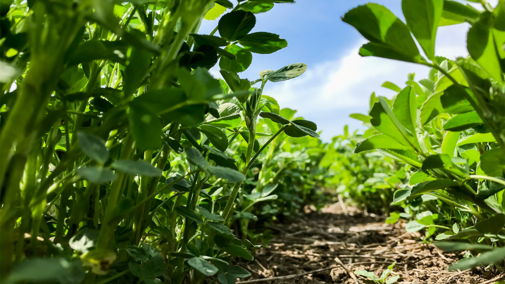Grass-alfalfa Mixtures
Interseeding cool-season perennial grasses into older alfalfa stands has been a good option to increase the productivity of that field. If planning a new alfalfa seeding this year, using a grass and alfalfa mixture can also have some advantages.
If you regularly feed more than five or six pounds of alfalfa per day to stock cows during winter, they probably are getting way more than enough protein but maybe not enough TDN or energy. Mixing grass with alfalfa usually lowers the protein but slightly increases the TDN content of hay. So, your cows actually could receive a more balanced diet. Also, if you sometimes graze your hay fields, grass will reduce the risk of bloat.
In the field, grass can grow in areas where alfalfa is not well-adapted or fill in spots as alfalfa dies out. This is better than having weeds invade bare areas. Grass-alfalfa mixtures often dry out more rapidly after cutting than pure alfalfa so you might get more hay made without rain damage. And if it does rain, grass sheds rain well so the mixture usually suffers less injury, both in the windrow and in the bale.
Yield-wise, protein yield may be less with the mix, but total tonnage usually is about the same or higher than pure stands. Most of the grass yield will come at first cut, so regrowth will be mostly alfalfa. Selling a mixture can be more difficult, though, because dairies prefer pure alfalfa and grass is more difficult to grind.
Orchardgrass is a top choice for seeding with alfalfa, but other grasses like smooth brome, meadow brome, festulolium or wheatgrasses will work as well. The seeding rate of the grasses will vary depending on the species that is used and what proportion of grass and alfalfa is desired.
Spring Alfalfa Weed Control
Spring is a critical time to control weeds in alfalfa. For Round-up Ready® or Tolerant varieties, glyphosate applications sprayed in early spring can assist alfalfa in effectively overcoming emerging weed, but Roundup® isn’t the only good weed control option.
When weeds grow faster than stressed alfalfa, seedlings are robbed of moisture, nutrients and light. Left uncontrolled, weeds can thin stands, weakened plants and lower yields. For broadleaf weeds, mowing may be an option while the alfalfa is growing slowly. Adjust mowing height so several leaves remain on the seedlings after clipping to aid in alfalfa regrowth. However, if mower clippings may smother young alfalfa seedlings, then alternative herbicide application may still be your best weed control option.
The Nebraska Extension “Guide for Weeds, Disease and Insect” publication EC-130 provides comparison herbicide response ratings. When establishing new alfalfa stands, Eptam®, Balan DF® and Trust® are labeled. For seedling alfalfa, post-emergent herbicides include: AIM®; Moxy 2E®; Poast®; Buctril®; Raptor®; Select Max®; Prowl H²O®; Warrant®; Pursuit®; Arrow® and Butyrac 200®.
For established alfalfa, labeled broadleaf or grassy herbicides include: Aim®; Moxy 2E®; Butytrac®; Chateau®; Gramoxone®; Karmex®; Metribuzin®; Prowl H²O®; Treflan®; Arrow®; MCPA Amine®; Warrant®; and Velpar®.
Remember that bottom-line, improved herbicide effectiveness begins with applying products early while the weed are less than four inches tall. As always, read and follow label directions for application rates and conditions.

